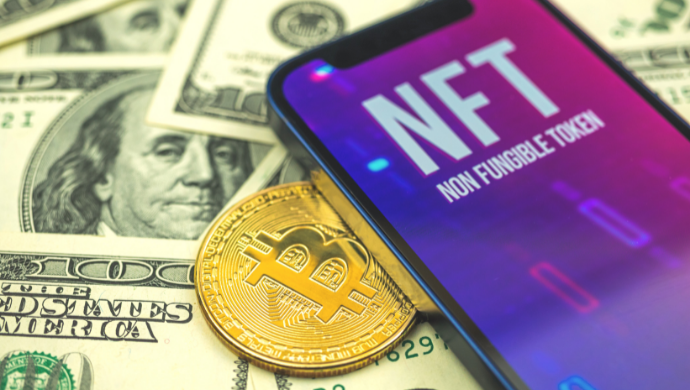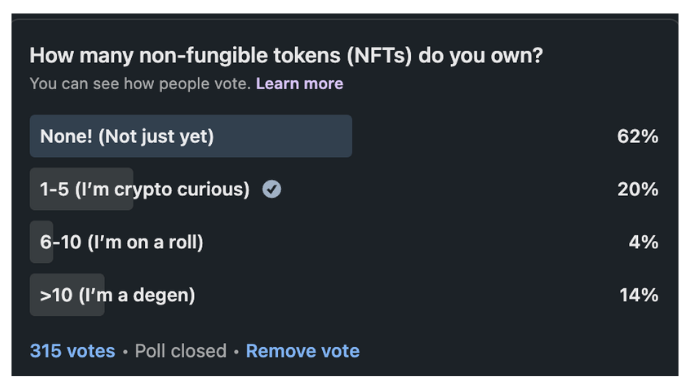
The recent surge in popularity of non-fungible tokens (NFTs) has fostered diverse conversations across many segments of society.
Some are bullish on these digital assets that are non-interchangeable and stored on a blockchain, leading to the growth of this industry from US$100 million in 2020 to US$41 billion in 2021, reaching near comparable levels to the conventional art market.
Others are less excited, calling NFTs elitist, encouraging bad art and environmentally unfriendly.

A poll conducted by the author to his LinkedIn network at the end of January 2022
What is clear is that we are in the early days; in an informal poll I conducted on LinkedIn two weeks ago, more than 6 out of 10 do not own NFTs.
While nascent technologies are prone to draw polarising views (e.g. the early 2010s when Facebook (now Meta) was criticised for enabling stalking compared to growing social capital), there are valuable career lessons that each of us can learn from the rise of NFTs regardless of our stance.
We, as individuals, are like non-fungible tokens. There can always be another designer, writer, engineer, investor, or entrepreneur, but no other designer, writer, engineer, investor or entrepreneur like you (non-fungible).
Just as tokens represent an asset or utility, we too represent value that we offer to our customers, users and employers.
Value yourself like an NFT
Liquidity: Like NFTs, talent is illiquid, unless established within a community with strong demand.
The non-fungibility nature of NFTs where one token is one of a kind and never precisely the same as another creates illiquidity.
Today, the majority of NFTs sold on OpenSea, the leading marketplace, have not been sold for 90 days or more, signalling that, for the most part, NFTs are not liquid.
Also Read: Making sound NFT bets: Think before you mint; ruminate before you ape
As a result of this illiquidity, it is hard to correctly price NFTs until a community forms around the NFT collection and a critical mass of individuals generates demand. Talent is no different.
The skills, knowledge and capabilities you have are illiquid until it is visible (a community recognises it) and desired (there is demand for it).
For example, I may be the best author in the world (I am not, stay with me), but if no one comes across my work (no community). There is no desire to read my work (no demand). I cannot convert this talent into value, whether further writing opportunities, engagement, network, or cold hard cash.
While it is tempting to focus on the returns, we can potentially gain from our talent (in the form of salary, stock, company benefits, etc.) as it is similarly tempting to obsess over the floor price and trading volumes from NFTs, it is worthwhile to take a step back and reflect on what community we want to visible to, and what we want to be desired for.
Understanding who and what gives us liquidity can identify if you are ‘correctly priced’ and valued in your current role.
Some questions to consider
- Who is the community I am part of? Is this the community I am proud to be part of? Whether you realise it or not, you are part of a community even if you do not work in tech. Your community is the group of people you most frequently interact with. It may not necessarily be your colleagues, for example, a teacher’s community is primarily one made up of students.
- Is the community around me sufficiently large for my ambitions? Just as founders and venture capitalists look for “billion-dollar market size”, the size of the community often determines the upper limit of what is achievable.
- Is there a desire for my skills and capabilities within this community I am in? Value is only created when there is demand. Why is one NFT collection worth 6/7 figures (Bored Ape Yacht Club) whilst others are sold in dollars? The fundamentals of supply and demand hold that value is created and recognised when many more people want what is less available.
Rarity and value are closely correlated, so find a way to be rare
This brings us to rarity. The rarity of NFTs, talent or anything else in the world is closely correlated with value. There is a caveat, though, what I discussed above has to hold first, rarity without a community that demands it is worthless.
I have a crushed piece of paper with some scribbles next to me as I write this article. This is a one of a kind, non-fungible artefact that is worthless because it is not visible by anyone, even if it is, it is not desired.
Happy to be proven wrong if anyone is keen on buying a crushed paper ball.
Also Read: More than hype: 3 reasons why NFTs are here to stay
The struggle we often face is: what is rare in today’s day and age, where everyone on social media seems to be killing it in their field?
In almost every nook and cranny, there appears to be champions and winners who have captured the lion’s share of the reward. What could possibly be rare?
As it turns out, NFTs can give us a clue. The rarity of an individual NFT within a collection is often not just defined by the rarity of a single trait (though it can be helpful to have a 1/1 trait), but the collective rarity across multiple traits.
Don’t have a particularly rare skill? Combine it with another, and it starts to be unique. Add in yet another for a trifecta combo, and the likelihood that you have a rare combination of skills that few others have increased dramatically. What are three skills that can make you one of a kind (or a 1/1 NFT) when combined?
Utility: The future is as important, if not more, than the present
The third key driver of an NFT’s value is utility. What do I stand to gain by owning the NFT?
The majority of NFT projects have roadmaps:
- “Compete against GaryVee in an hour-long ping-pong duel!” (VeeFriends)
- “Every Lazy Lion owner can receive a banner image NFT featuring their own unique, randomly generated private bungalow!” (Lazy Lions)
- “We will launch a children’s storybook NFT” (KumoXWorld; Disclaimer: I’m a Kumo Resident; aka own a KumoXWorld NFT).
The most successful NFTs sell the future alongside the present. Why might one spend 6 to 7 figures on a Bored Ape Yacht Club (BAYC) NFT?
Besides the hedonic value and social status, the future of BAYC is exciting more NFTs (spins offs such as the Bored Ape Kennel Club) or exclusive invites to events from New York to Hong Kong.
Also Read: Demystifying NFTs and DeFi
We are no different when pitching ourselves to prospective employers, investors or partners in answering the question. “What do you stand to gain by working together with me, besides what I can bring today?”
Laying out where you are headed generates not only excitement (“I want to be associated with you before you reach your ambitions”) but also creates alignment (“Let’s grow together”).
I find the most exciting NFT roadmaps to be those where the community is actively involved in shaping future outcomes. There is an innate desire for humans to be part of something bigger than ourselves.
We are drawn towards the opportunity to shape our future alongside others who share similar interests or goals. Find individuals within the community that recognise your talent, and enlist them in your journey.
While rareness, liquidity and utility are helpful to assess the value of NFTs, it is important to recognise that value is ultimately in the eyes of the beholder. What is valuable to me may not necessarily be valuable to you.
It is common for us to think of careers defined by the companies and roles. Yet, decisions on how we are valued are ultimately made by ‘buyers’, individuals seeking us out for our talent, such as the recruiters and hiring managers (if you are an employee) or customers and investors (if you are a founder).
These decisions, like NFT pricing ones, are often based on highly subjective preferences, which is why it is critical to find the right ‘buyer’. Individuals who value us for who we are and want to engage with.
There is much we can learn from the boom in NFTs to shape our careers, discover a community that desires what we can offer (be liquid), develop a combination of skills (be rare), bring others alongside you for the ride (showcase utility), and above all, surround yourself with individuals who value us for who we are (right buyer).
While the jury on the impact of NFTs is still out, we can all take a leaf and increase our value at the workplace.
–
Editor’s note: e27 aims to foster thought leadership by publishing views from the community. Share your opinion by submitting an article, video, podcast, or infographic.
Join our e27 Telegram group, FB community, or like the e27 Facebook page
Image Credit: fellowneko
The post How to value yourself at the workplace like NFTs appeared first on e27.


I don’t think the title of your article matches the content lol. Just kidding, mainly because I had some doubts after reading the article.
Your article helped me a lot, is there any more related content? Thanks!